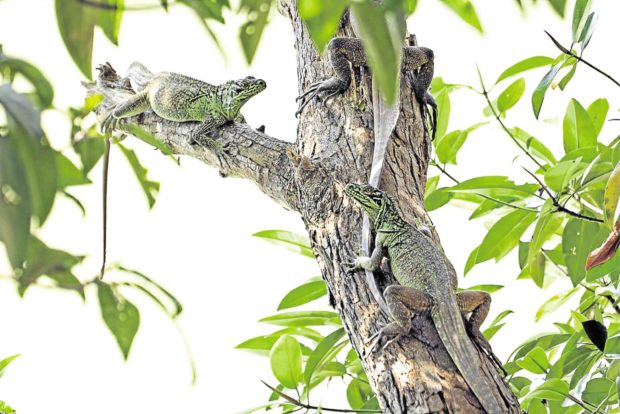DENR, local execs seek habitat protection for ‘ibid’

ENDANGERED “Ibid,” or sailfin lizards, in their habitat on the Solana River in Jasaan town, Misamis Oriental. —ERWIN MASCARIÑAS
JASAAN, MISAMIS ORIENTAL—Amid a move by the Department of Environment and Natural Resources (DENR) to open up protected areas, one of its offices in Northern Mindanao and the provincial government of Misamis Oriental were pushing to declare parts of a river here as protected habitat of a lizard species that was being threatened by massive hunting.
The Philippine sailfin lizard (Hydrosaurus pustulatus), locally known as ibid, calls the lower Solana River as its home but conservation experts said its population was dwindling rapidly because of hunting.
The lizard was only one of two species in the Philippines. The other, Hydrosaurus amboinensis, is found in the country’s northern areas.
To protect the lizard, the Protected Area Management and Biodiversity Conservation Section (PAMBCS) of the DENR recommended the declaration of parts of this town’s river, where the lizards live, as a critical habitat.
Delicacy
Ranoray Love Noro, section chief of the PAMBCS in Northern Mindanao, said his office was now on the final stage of having the lizards’ habitat, the lower Solana River, as critical, which would bar all forms of development or encroachment.
Noro said the provincial government of Misamis and the local government of this town have been “very supportive” of the move.
The lizards are a delicacy for most people and massive hunting was now threatening their existence.
Some are being hunted for export, fetching up to $650 (P34,028.54) per kilogram in the United States.
The provincial government had initiated the bid to declare the lizard habitat as critical, according to Noro.
Noro said his office quickly gathered data to support the declaration and would soon submit requirements to the DENR office in Manila with endorsement and support from village, town and provincial officials.
Donato Bojo, zoology technician of the regional PAMBCS office, said he was confident that the sailfin lizard habitat would be declared as a protected area in the next few months.
He said his office was now in the “final stages of completing the mapping of the area.”
Mapping
Covered by the proposed protected area were 3 hectares along the Solana River and a 20-meter area along another side of the river that had been spared so far from human settlements.
Residents near the area were expected to help in the preservation of the lizard.
Bojo estimated that only at least 100 adult lizards could be found along the river today.
In the village of Lower Solana in Jasaan, scientists studying the lizards found the animals to have adapted to living among humans. The village has at least 550 households.
Among those helping protect the lizards and feeding them on a regular basis was 77-year-old Rodulfo Dael and his wife, 65-year-old Alma.
Lost fear
The couple had volunteered and taken the task of feeding the lizards for 16 years now.
Dael said the lizards had been “very elusive” in the past.
But in 2002, he said the lizards appeared to have lost their fear of humans. He recounted feeding bananas to three small lizards that approached him and his wife.
“After that they kept coming back,” Dael said.
He said people had been hunting the lizards in big numbers using rifles, handguns, other weapons and nets.
Alma said she had tried to ward off hunters, but could only do so much.
The Dael family had since been tapped by the provincial government to help in protecting the lizards.
In 2016, national scientist Dr. Angel Alcala, who published the “1986 Guide to Philippine Flora and Fauna”—a source for lizard researchers—said, the situation inside the habitat here was very unique and unusual.
‘Strange occurrence’
“Never have I heard or seen such a strange occurrence of these species having built a strong bond with a family,” Alcala said in his guide, referring to the Dael family.
The International Union for Conservation of Nature (IUCN), the world’s most comprehensive inventory of the global conservation status of biological species, listed the Philippine sailfin lizard as a threatened species.
According to the IUCN Red List of Threatened Species, sailfin lizards were considered vulnerable because their population was expected to decline by more than 30 percent in a 10-year period.
The main causes of the population decline, the IUCN said, was “habitat loss and the very heavy collection of this species for the pet and food trade.” —ERWIN MASCARIÑAS














